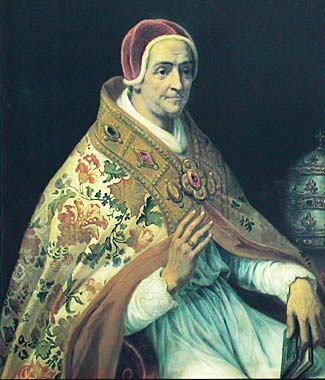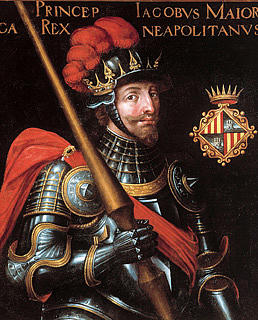 |
| Joanna |
A Wedding
Along with
the shortage of money; the lack of an heir was also affecting the stability of
the kingdom. And Louis of Hungary had turned his attention back to the kingdom
he coveted. Like Joanna Louis lacked direct heirs[i]; Louis had invited the
young Charles of Durazzo to Hungary; at the age of seven Charles was sent to a
foreign land where he was fostered by the man who had his father executed.
Louis
proposed a marriage between Charles and Margherita; Joanna’s only remaining
unmarried niece. Urban favoured the marriage and on 15th June 1369
issued a bull approving the union. With the free companies still menacing the
papal states, Urban hoped to persuade Louis to send his soldiers to fight for
the good of the church.
%2C_Visegr%C3%A1d.jpg/460px-K%C3%B6nigsschlo%C3%9F4_-_M%C3%A1ty%C3%A1s_Kir%C3%A1ly_M%C3%BAzeum_(K%C3%B6nig-Matthias-Museum)%2C_Visegr%C3%A1d.jpg) |
| Royal palace at Visegrad |
Joanna
reluctantly agreed to the match and the 13 year old Charles of Durazzo returned
to Naples to marry the 22 year old Margherita at Castel Capuano in January 1370. By the time Charles returned to Hungary
Margherita was already pregnant. Her little girl, Marie, died not long after
birth and Margherita travelled to Visegrád to join her
husband.
By
mid-summer the Romans had had enough of the papal court; Urban shamelessly
preferred Frenchmen to the Sacred College and John Hawkwood was on the attack,
targeting papal property for preference. Eventually Urban, by now a very sick
man, gave way to the pressure and agreed to return to Avignon. Joanna provided
34 galleys to ferry the pope’s court back to Provence.
‘Sad, suffering and deeply
moved’
War in Italy
 |
| Catherine Benincasa |
On 9th
May 1372 the new pope announced
to his cardinals that
the papal court would return to Rome; his decision reinforced by the support of
Catherine Benincasa[iii]. The papal treasury was empty and
not only the French cardinals and the king of France, but also the king of
England was opposed to the move. Gregory had to borrow 60,000 gold florins[iv] from the Duke of Anjou and another 3,000[v] from the king of Navarre to keep the papacy’s creditors at
bay. The return to Rome had to wait another 4½ years.
And money
was not the only issue; Bernabo Visconti was on the warpath in the Romagna.
Gregory authorised Cardinal Robert of Geneva to raise an army of mercenaries; he
contracted with John Hawkwood to swap sides when his contract with Visconti
expired.
‘The pope has learned that
the said John intends to abandon the service of Barnabas de Vicecomitibus
[Visconti], to invade no more the church and its lands, rather to serve the
same and the realm of Naples.’[vi]
Robert
blockaded Bologna and allowed his mercenaries to commit atrocities while laying
the countryside to waste. Robert then sent the troops to raze Cesena; an atrocity that was partly the cause of the War of the Eight Saints pitting the Italian city states
against the expanding reach of the papacy.
Marriage Number Four
Joanna was
relieved of her third husband James in February 1375, felled by the ill-health
that he had long suffered;
With no
direct heir in sight, Louis of Hungary again raised the issue of Hungarian
rights in Naples. As part of his campaign Louis wed his daughter Catherine to
one of the king of France’s sons, Louis, Duke of Touraine[viii]. The settlement stated that
Catherine was dowered with the domains of Naples, Provence and Piedmont. Gregory refused to accept the document and warned Joanna of Louis’
plans.
On 25th
March 1376 Joanna married Otto, Duke of Brunswick, a soldier in the service of his
cousin the Marquis of Montferrat[ix]. Spinelli recommended the
marriage to Joanna as a way of securing control of Piedmont. Otto, the most
reliable and supportive of all her husbands, was rewarded with the title of the
Duke of Calabria and the principality of Taranto[x]. In a letter to King
Louis, the Florentines claimed that Joanna was;
‘Humiliating Italy by mixing
the blood of the glorious Angevin race with the detestable blood of a German
prince.’[xi]
In the
summer of 1376 Margherita and her four children returned from Hungary to live
at Joanna’s court.
The Papacy Divided
 |
| Pope Urban VI |
Gregory died
in March 1378 and the Romans demanded that his replacement be an Italian. Under
duress the flawed election saw a Neapolitan crowned Urban VI, while Robert of Geneva was left on the sidelines. The new pope was not
a reasonable man, being;
‘One of the most arbitrary,
and, indeed, insane of all the popes…..usually described as , capricious,
arbitrary, deceitful, distrustful, nepotistic and vengeful, even by his
defenders.’[xii]
The French
cardinals slipped away and from the safety of Anagni demanded a fresh election, Urban’s election was declared invalid. Moving
to Fondi they elected Robert of Geneva as Clement VII, to become
known as the Antipope; the Western Schism had begun.
The next
step was to get rid of the unwanted Urban, who failed to respond to the offer
from Fondi to step down. Clement hired mercenaries to attack Rome and Urban. On
16th July Clement’s troops won a victory over the Romans and Urban,
a Neapolitan, begged Joanna for assistance.
 |
| Antipope Clement VII |
The
cardinals at Fondi sent representatives to Joanna and managed to persuade her
of the invalidity of Urban’s election. Joanna’s support henceforth was given to
Clement, for which she was reproached by Catherine Benincasa, one of Urban’s
supporters;
‘You who
were a branch of the true vine, have cut yourself off from it with the knife of
self-love. You who were a legitimate daughter, tenderly beloved of her father,
the Vicar of Christ on earth, Pope Urban VI., who is really the Pope the
highest pontiff, have divided yourself from the bosom of your mother, Holy
Church, where for so long a time you have been nourished. Oh me! oh me! one can
mourn over you as over a dead woman.’ [xiii]
The king of
France was particularly delighted over the decision to declare Urban’s election
invalid and the re-election of Clement. Against Clement were ranged the Holy
Roman Emperor, the king of England and the king of Hungary.
Hungarian Interference
 |
| Castello Fondi |
On 22nd
November 1378 Joanna declared for Clement, sending her annual tribute to him;
she was immediately declared an enemy of the church. Joanna’s people saw the
matter through different eyes, unable to understand why their sovereign was not
supporting the Neapolitan pope. Rioting broke out in the streets and fighting
raged through L’Aquila.
In May 1379
Clement and his supporters were forced out of Fondi and fled to Naples.
Violence broke out in the city led by Ludovico Buzzoto[xiv]; the rioting persuaded
Clement that his best recourse would be to return the papacy to Avignon and on
13th May, Clement and his cardinals left in galleys provided by
Joanna.
Despite
Clement’s departure, the violence continued; with Otto in Piedmont, on May 18th,
in a charade to fool her subjects, Joanna ostensibly reversed her stand and
came out in support of Urban. When Otto returned to Naples in July, Joanna made
plain her adherence to the man she believed was the true pope, at the expense
of losing her subjects’ trust. Urban was livid, calling Joanna;
‘The new Jezebel and the
height of impiety.’[xv]
Louis of
Hungary saw Joanna’s break with Urban as his chance to intervene once more in
the affairs of Naples. Louis agreed to send Charles of Durazzo, a seasoned
warrior, to conquer Naples. Clement decided that Joanna needed more than just
Otto to safeguard her kingdom against the Hungarians. Louis of Anjou[xvi] agreed to raise an army
to come her Joanna’s aid if Joanna adopted him as her legal heir.
In June 1380
Margherita slipped away from Naples with her children. She had been living as
part of the court for the past four years, with no evidence of ill feeling
between her and her great aunt. Joanna, who had been ambivalent about declaring
Louis of Anjou as her heir, now did so on 29th June in a letter to
Clement. He issued two bulls on 22nd and 23rd July
confirming Joanna’s decision.
A New King
 |
| Louis d'Orleans |
In July
Charles of Durazzo left the Veneto, where the Hungarians had been fighting an
alliance of city states, and by November his army of 7,000 was in Rome, to be
welcomed by Urban. Naples prepared for war and Joanna called on her heir to
come to her rescue. Louis was now Regent of France for his nephew Charles VI and was loath to risk his
comfortable position in France to fight the Hungarian army.
Urban
invested Charles of Durazzo with the kingdom of Naples on condition that he
hand over the towns of Capua, Caserta, Avera, Nocera and Amalfi to Urban’s nephew. Charles agreed and on 2nd
June 1381 Charles was crowned Charles III of Naples. Six days later he rode out
of Rome at the head of an army of Hungarians and Italian mercenaries.
On 24th
June Charles’ troops defeated the Neapolitan army under the leadership of Otto
of Brunswick at Palestrina. Otto and his men fell back on the Porta Capuana[xvii] but were betrayed by adherents of
Urban; Naples was opened to the invaders.
 |
| Porta Capuana |
‘’Huzza’ they shouted ‘God
save King Charles and pope Urban!’…..They easily beat off those of the Queen’s
party, and forced them to retire to the castle, while they opened the Porto del
Mercato, at which Charles with his army entered.’[xviii]
Joanna was
besieged in Castel Nuovo. Besides her court, Joanna had opened the doors of the
castle to 500 citizens afraid of retribution from the Hungarians. In August
Otto made an attempt to free his wife and was captured. In the absence of any
sign of help from Louis of Anjou on 26th August 1381 Joanna
surrendered. She was originally held at the Castel dell’Oro and was moved to
the fortress of San Fele in March 1382.
In June 1382
Louis of Anjou felt secure enough to come to the rescue; he left Carpentras with an army of 60,000 to march down through Italy. Aware
that the French were marching to the rescue and feeling that he would be unable
to overcome such numbers, Andrew had Joanna killed. The accounts vary; Joanna
was either strangled, poisoned or suffocated with a feather mattress; but all
accounts agree that the deed was done by four Hungarians.
Bibliography
The Letters
of Catherine Beneseca – Catherine Beneseca, Project Gutenberg 2003
Chronicles –
Froissart, Penguin Classics 1968
Joanna –
Nancy Goldstone, Phoenix 2010
Absolute
Monarchs – John Julius Norwich, Random House 2011
Hawkwood –
Frances Stonor Saunders, Faber & Faber 2004
A Distant
Mirror – Barbara Tuchman, MacMillan London Ltd 1989
www.wikipedia.en
[i]
His niece Elizabeth
was next in line to the throne of Hungary; she married Philip II of
Taranto in 1370
[ii]
A nephew of Clement VI
[iii]
Now known as St Catherine of Siena
[iv]
In 2013
the relative: historic standard of living value of that income or wealth is £36,280,000.00 economic status value of that income or wealth is £1,326,000,000.00 economic power value of that income or wealth is £16,300,000,000.00 www.measuringworth.com
[v]
In 2013
the relative: historic standard of living value of that income or wealth is £1,814,000.00
economic
status value of that income or
wealth is £66,290,000.00 economic power value
of that income or wealth is £815,000,000.00 www.measuringworth.com
[vi]
Hawkwood – Stonor Saunders
[vii]
Joanna - Goldstone
[x]
Robert, the last of the three brothers, died in 1373
[xi]
Joanna - Goldstone
[xii]
Ibid
[xiii]
Letters – Catherine Benincasa
[xiv]
A militant cleric, named as bishop by Urban and deprived of his archbishopric
by Joanna
[xv]
Joanna - Goldstone
[xvi]
His Hungarian fiancée Catherine had died a couple of years earlier
[xvii]
One of the gates into Naples
[xviii]
Joanna - Goldstone





